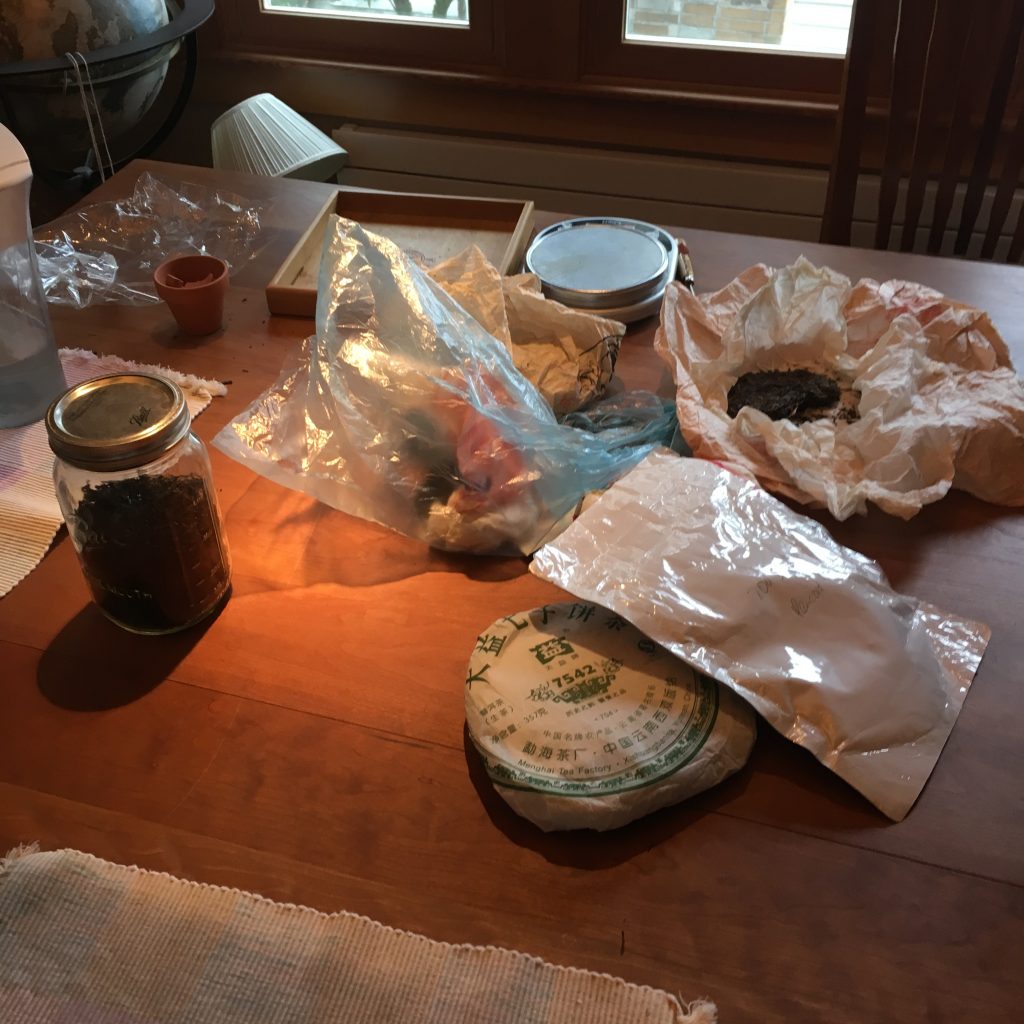I’ve had the opportunity to participate and host a number of group sessions since I got into tea. The context varies.. Some have been with a couple people unfamiliar with tea, others are with regular tea friends. This article on a couple approaches to choosing what to brew sequentially in a group setting and a few more of my thoughts that I thought I’d share.

Approach 1: Stronger Contrasts
Emphasizing big differences or more obvious contrasts is where you’d pick a few, inherently different, types of tea. For instance, you could start with a green Taiwanese oolong, moving onto an aged oolong, and then a raw pu’erh. All three are quite different and you don’t need to have an experienced palate to tell the difference.
When you’re serving tea for a newer drinker or two, I find this approach wells. Most people living in the west aren’t familiar with the most basic types of Chinese tea and covering a range of teas is a good way for them to sample different profiles. You can also use the initial teas to inform teas later in the session by narrowing down their taste and figuring out where their tastes lie. You can also audible out of this approach and stick with a specific type of tea if you find your guest likes a particular type of tea.
Approach 2: Brewing Similar Teas
Context plays an extremely important role in our perceptions. When I’m considering buying a tea, I like to do a back to back or side by side brewing comparison with a similar(ish) tea that I know well. Our judgement and perception of things is biased by what immediately came before it. What may seem like subtle or unnoticeable differences (if the two teas are consumed on different days), can be much more pronounced and obvious when brewed side by side or close to one another.
For a group session when you’re brewing teas back to back, the contrasts also end up being more obvious. Brewing teas from a similar type or age will inherently showcase the differences between the teas. This approach is good with more experienced drinkers if you decide you want to study or brew a few similar teas with. As a contrast, the nuances might be a little more lost on a novice drinker.
For instance, friend of the show Garrett and I nearly always brew teas fitting into a certain category when we meet up for tea (i.e. semi-aged factory, boutique, roasted oolongs, ripe). We are both well-aware of each other taste and drinking like this is an informative way to dive a little deeper into specific teas. Typically we’re not specifically trying to test a certain tea, we simply prefer this approach rather than a random smattering of heavier-contrasted teas.

Other Bullet Points
- I like to serve oolongs as the initial tea, especially for non-drinkers. Oolongs tend to be well-liked and a little less challenging than some of the more acquired tastes of the tea world (pu’erh).
- I often prefer to start with lighter, more aromatic teas before moving to heavier teas. If you do the reverse, it can be difficult to fully taste and appreciate the lighter teas. For instance, try brewing a really smoky Xiaguan tuo and then trying to taste some green Taiwanese oolong immediately after. This is another good reason to start with an oolong.
- (Relevant to point 2). You can also try to reset your palette with small snacks. Most people like basic, relatively neutral foods like nuts, rice crackers, or bread.
- If you’re brewing similar teas, it can be helpful to not brew the tea all the way and leave the tea in its brewing vessel. This way you can do a side-by-side later in the session if there’s interest.
- The ideal group size probably depends on your preference. For me, I prefer groups of 1-3 other people. With more than 4 people, there’s more to worry about. YMMV though, and more extroverted people may enjoy big, group sessions.
- Don’t destroy your guests. When I first had some tea sessions with novice drinkers, I didn’t moderate my brewing enough. Your goal should not be to make everyone have a sleepless night. I usually shoot for 3-4 teas per session. Depending on the group size or if you don’t want to brew the teas all the way, it can be appropriate to do more.
- Some teas aren’t as great for newer drinkers. You may be super passionate about boutique raw pu’erh, but don’t expect your guests to like it in the same way you do. Try one out, but don’t plan a deep dive unless they seem into it.
- If you plan on bringing out some really good tea you want to highlight, don’t do it too late. It’s tempting to wait until the very end, but don’t wait until you’re 3 hours and hangry to whip it out. My preference for very good tea is to usually do it 2nd or a quick 3rd in the lineup.

Leave a Reply